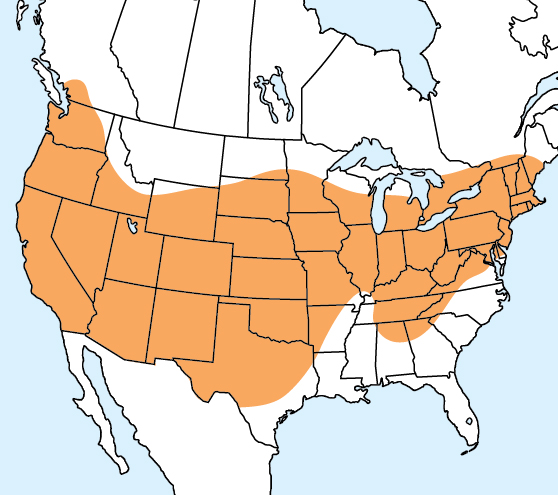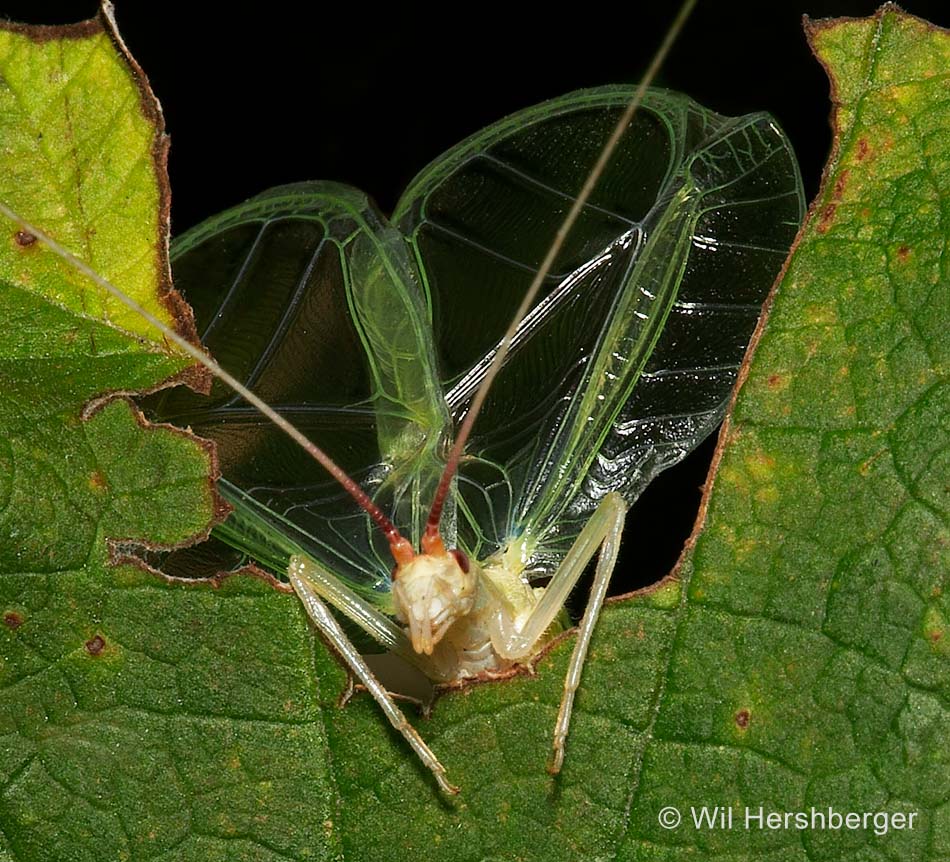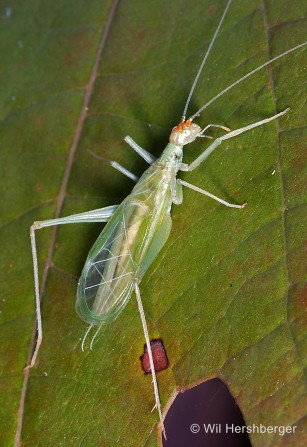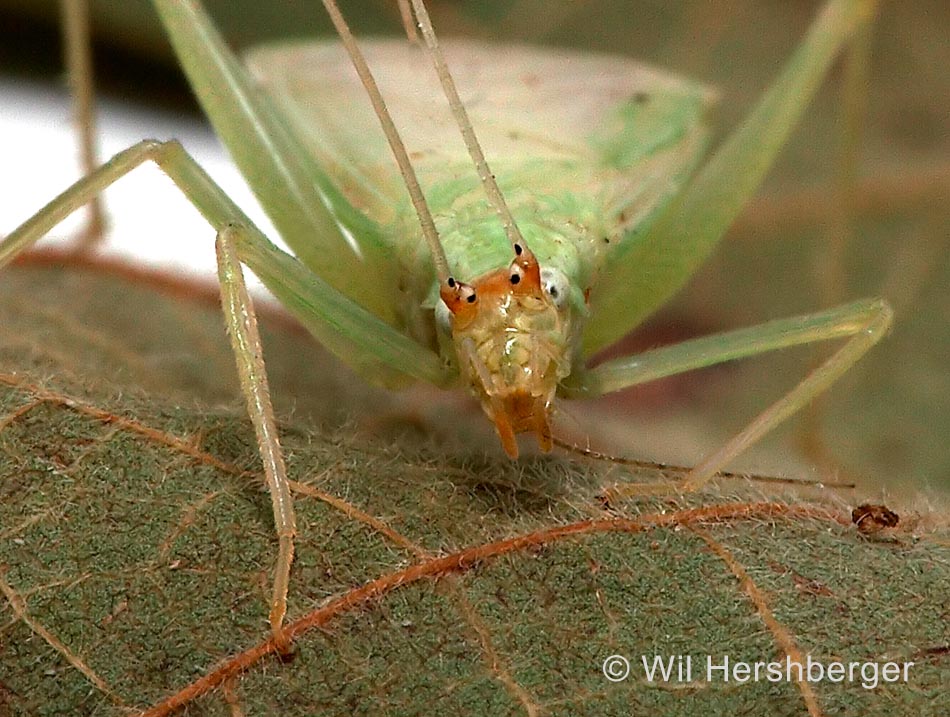Snowy Tree Cricket – Nature’s Thermometer
A Nature Vignette by Lang Elliott
Perhaps the most familiar of our tree crickets, the Snowy Tree Cricket (Oecanthus fultoni) is a species whose chirp rate can be used to estimate the temperature. One popular formula is to count the number of songs given in thirteen seconds and then add that number to 40 to yield the temperature in Fahrenheit. That’s seems easy enough, so why not determine for yourself the approximate temperatures of the two singing males featured in the above video … then share your results in the comment section below.
This wide-ranging tree cricket, found across much of the United States, is referred to as “Snowy” because individuals are sometimes so pale that they appear white (although a number of other tree cricket species are similarly attired). It frequents brushy understory plants at the margin of woods or within open woods. During cold spells, Snowys can also be found close to the ground on the trunks of small trees – here they probably find a warmer microenvironment.

The male’s song is a pleasant series of evenly-spaced chirps, each chirp actually consisting of 8 (occasionally 5) pulses, given too fast to differentiate. In the following recording, you will hear eight songs at normal speed, followed by slowed and lowered songs that allow you to hear that each chirp is indeed composed of eight pulses, delivered in a slightly uneven rhythm:
Males prefer to sing from the underside of branches or dead leaves, but sometimes position themselves in a hole in a leaf or else in the “V” created when two leaves overlap (as demonstrated in the video). Furthermore, as you can see for yourself in the video, they have no problem singing upside down!
Stereo Soundscape Featuring Snowy Tree Crickets:
Two neighboring males (one to the right and the other to the left) begin singing in unison but occasionally drift apart and then return to unison. It is common for neighbors to synch their songs in this manner. From a distance, one might actually think it’s just one cricket singing. Note the Barred Owl hooting in the background.
Recorded 11 August 2010 around 11pm near Ithaca, New York. © Lang Elliott.
Snowy Tree Crickets can be very difficult to locate because of the ventriloquial quality of their song. Finding them is further confused by sound reflecting off of, and being absorbed by, surrounding leaves. Sometimes, a male’s call actually gets softer as you approach him, because nearby leaves block the sound. In addition, if you shine a flashlight in the direction of the singing male, he’ll usually collapse his wings and then hide behind a leaf, at times giving his position away unknowingly as he waves his antennae beyond the leaf’s edge.
- The Snowy Tree Cricket, Oecanthus fultoni, is a member of the subfamily Oecanthinae. There are 20 species of tree crickets in North America. Nearly all are elongate and pale green or brown in color.
- Like all our native crickets, the male’s song is produced by structures on the wing. One wing has a ridged area called a “file” and the other wing has a “scraper.” A chirp is produced by the rapid vibration of one wing against the other, of the file against the scraper.
- When singing, the male raises his wings straight up and often positions himself under a leaf, and in many cases at the edge of hole or at the “V” where two leaves overlap.
- Neighboring males often synchronize their singing such that a small group may be heard singing in unison.
NOTE: For additional information, see the Snowy Tree Cricket’s profile in Our Insect Musicians.
What You Can Do:
If it’s late summer and you’re within the Snowy Tree Cricket’s breeding range, the easiest thing for you to do is to verify the temperature formula, to see how well it works in the field. Measure the air temperature (in Fahrenheit) with a thermometer. Then count the number of chirps in 13 seconds and add 40 … the resultant value should be within a few degrees of the actual temperature. Try doing this on several different nights where the air temperatures are quite different. You may also want to find out if the formula holds up when it gets cold late in the season.
Finding and observing a singing male can be challenging indeed, because males will quit singing at the slightest disturbance and they do not like to be in the bright beam of a flashlight. But don’t let this deter you because eventually you will get lucky and find one.
The first thing to do is determine a singing male’s whereabouts in a shrub. The best way to do this is to “triangulate” his position. This is easily accomplished if you have a helper. If the two of you approach from different directions and then both of you point to where you think he is, his actual location will be where the two “pointing lines intersect”.
The next part is the most difficult. Shine your light where you think he is. Look for subtle movements, or your light reflecting off his wings. Often, the male will wave his antenna, which may be visible to you even when his body is hidden behind a leaf. Make sure you look at the underside of leaves as well as their tops. Search also for holes in leaves, because males often sing at the edge of a hole.
If the male quits singing when you shine your light, he often keeps his wings expanded for a number of seconds, allowing you to find him. Usually, though, he retracts his wings and moves out of the light. In such cases, you will need to turn off your light and wait several minutes until he commences singing again. If you get frustrated, please don’t lose heart. If you persist in your searching and try several different males, you’re sure to finally get a good view of the singing male, with his wings held straight up as he sounds off!
If you’re in an area where there are lots of males singing, listen for groups that are synchronizing their songs. Often, the synchronization seems near-perfect, but if you listen for five or ten minutes, you will discover that neighboring individuals often drift out of synch before re-synchronizing some thirty seconds (or so) later. It’s quite the experience to sit within a group where males are all singing in synch. It’s as if a single cricket is throwing his voice all around you … the ultimate expression of insect ventriloquism!
Wherever there are singing males, there is mating behavior, although it’s difficult to observe. Just prior to mating, the male courts the female by approaching her while singing. If all goes well, the female climbs atop the male and feeds on secretions from glands on his back, as he produces a sperm packet (spermatophore) which is transferred from the tip of his tail to her tail. If you search long enough, you’re sure to find a mating pair.
Once mated, the female finds a suitable stem and begins laying her eggs. She pierces the stem with her sharp ovipositor, lays a group of eggs, moves upward on the stem, and then repeats the performance. If you search in the proximity of singing males, it is often fairly easy to find and observe a female laying eggs.
The Snowy Tree Cricket is perhaps my favorite singing insect. Here in upstate New York, I hear the first singers in early August. By mid-August, the chorus is in full bloom and the night soundscape is alive with their pulsing chirps. Every year I excitedly search for singing males and mating pairs, as if I were a child hearing and seeing them for the very first time.
Notes from the Author (Lang Elliott):
 Of all our native tree crickets, this one is my favorite, due to its pleasant demeanor and its sweet, rather low-pitched song. But one thing is for certain: these buggers are difficult to videotape while singing! Not only are they hard to find, but they are easily disturbed, and they don’t like to be in the light.
Of all our native tree crickets, this one is my favorite, due to its pleasant demeanor and its sweet, rather low-pitched song. But one thing is for certain: these buggers are difficult to videotape while singing! Not only are they hard to find, but they are easily disturbed, and they don’t like to be in the light.
I worked very hard to get the two singing sequences in the video, enticing the two males to sound off by turning my light off, and then back on when they finally started performing. After a few tries, they seemed to get used to my antics. I can’t wait to capture more footage of this fantastic insect songster!







Nice leaf mine! Must be some sort of Aulagromyza.
Charley: are you referring to the leaf miner hole at the lower right of the last video clip? If big enough, I’m sure tree crickets would make use of leaf miner holes for singing purposes. I’ll try to get a video of that.